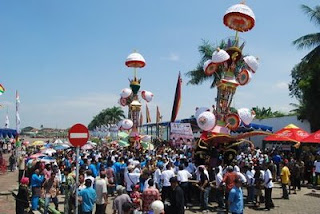 Rumah gadang (Minangkabau language: 'big house') are the traditional homes of the Minangkabau. The architecture, construction, internal and external decoration, and the functions of the house reflect the culture and values of the Minangkabau. A Rumah gadang serves as a residence, a hall for family meetings, and for ceremonial activities.
Rumah gadang (Minangkabau language: 'big house') are the traditional homes of the Minangkabau. The architecture, construction, internal and external decoration, and the functions of the house reflect the culture and values of the Minangkabau. A Rumah gadang serves as a residence, a hall for family meetings, and for ceremonial activities.With the Minangkabau society being matrilineal, the rumah gadang is owned by the women of the family who live there - ownership is passed from mother to daughter. The houses have dramatic curved roof structure with multi-tired, upswept gables. Shuttered windows are built into walls incised with profuse painted floral carvings. The term rumah gadang usually refers to the larger communal homes, however, smaller single residences share many of its architectural elements.



